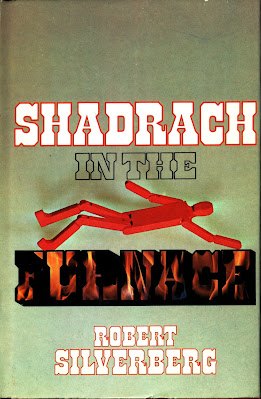Book Review: 'Shadrach in the Furnace' by Robert Silverberg
1 / 5 Stars'Shadrach in the Furnace' (247 pp.) first was published in hardcover in 1976 by Bobbs-Merrill, with a cover illustration by Fred Samperi. A mass market paperback edition was released by Pocket Books in February, 1978.
'Shadrach' is set in 2012. A series of geological catastrophes, and the Virus War, have caused the downfall of the West and allowed a Chinese Communist Party apparatchik, the Mongolian Genghis II Mao IV Khan, to install himself as a global despot.
From his complex in Ulan Bator, Genghis Mao Khan - who is ninety years old - surveils events all over the world from a network of CCTV cameras. Dissent from his rule is negligible, hampered by the fact that most of the global population slowly is succumbing from the disease of 'organ rot', with treatment offered only to those in the Khan's inner circle.
The eponymous Shadrach Mordecai is the Khan's personal physician. A black American man, Shadrach is personable, skilled, and utterly affectless about the disastrous state of the world. Living a life of privilege, sheltered in the complex in Ulan Bator, Shadrach attends to the increasing medical needs of his patient, who requires regular transplants of organs procured from the viscera of comatose rebels and dissidents interned at the 'Organ Farm'.
When not providing care to his autarch, Shadrach enjoys dalliances with two female scientists on the Khan's staff, who are working on methods to increase the longevity of their employer. Shadrach also enjoys frequent trips to the pleasure city of Karakorum, which offers a variety of recreational delights to the Khan's bureaucrats and functionaries.
I'm not spoiling anything by revealing that Shadrach's idyllic life soon is to be disrupted by the discovery that the Khan hopes to extend his life, and regain his youth, by having his consciousness downloaded, as it were, into the body of one of his subjects.
And it is Shadrach who has been chosen for this peculiar 'honor'..............
So 'Shadrach in the Furnace' would seem to have an intriguing, inherently gripping premise: our hero knows he is in a metaphorical furnace, so what will he do to save himself ? Unfortunately, with this novel, Silverberg's approach to plotting is so anemic that the novel never achieves much in the way of drama or excitement.
Indeed, Shadrach doesn't learn he's been selected to be the repository of the ailing Khan's consciousness until page 123, and despite that revelation, Shadrach eschews any sort of urgency. We are treated to expositions on the use of woodworking as a meditative tool. There are phantasmagorical excursions into Virtual Reality (as it was envisioned in 1976). Shadrach has melodramatic exchanges with his girlfriends. And in the closing chapters of the novel, Silverberg has Shadrach indulge in travel to places around the globe, this serving as a mechanism to advance Shadrachs' personal growth, and empathy with the masses of humanity suffering under the Khan's despotism.
These divagations ensure that, when it finally arrives, the novel's denouement is underwhelming and contrived, and failed to justify the investment in time I had made for the preceding 242 pages.
The verdict ? Like most (all ?) of Silverberg's New Wave era novels, 'Shadrach in the Furnace' suffers from a preoccupation with characterization over plotting, and an emphasis on discourses into humanistic themes, discourses that can't help but seep momentum from lethargic narratives.
It's interesting to note that after the release of 'Shadrach' Silverberg published no new works for four years, and when he did resume publishing, it was the combined fantasy / sci-fi novel 'Lord Valentine's Castle'.
'Valentine's Castle' was considerably more energetic and plot-driven than Silverberg's New Wave entries, and as a result, also was more commercially successful.
I am comfortable with a One Star Review for 'Shadrach in the Furnace', as it is only for those readers with the patience for a dilatory narrative that exemplifies the New Wave ethos.










.jpg)
















